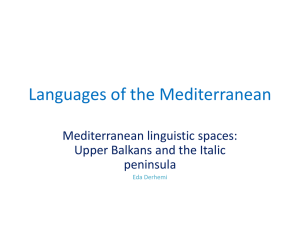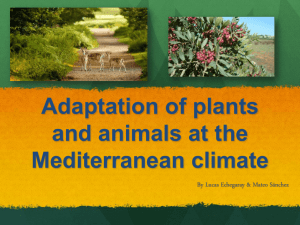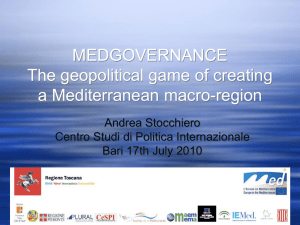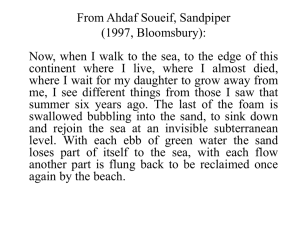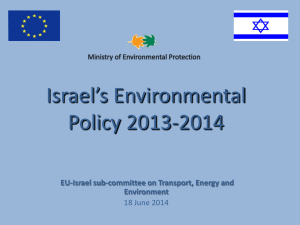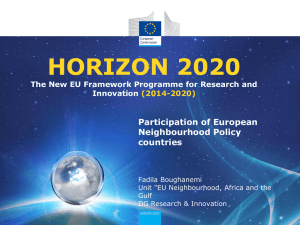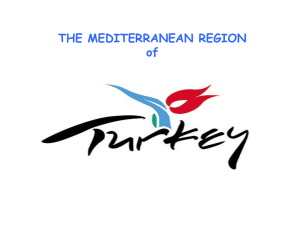Euro-Mediterranean Partnership: A Study in EU - IP
advertisement
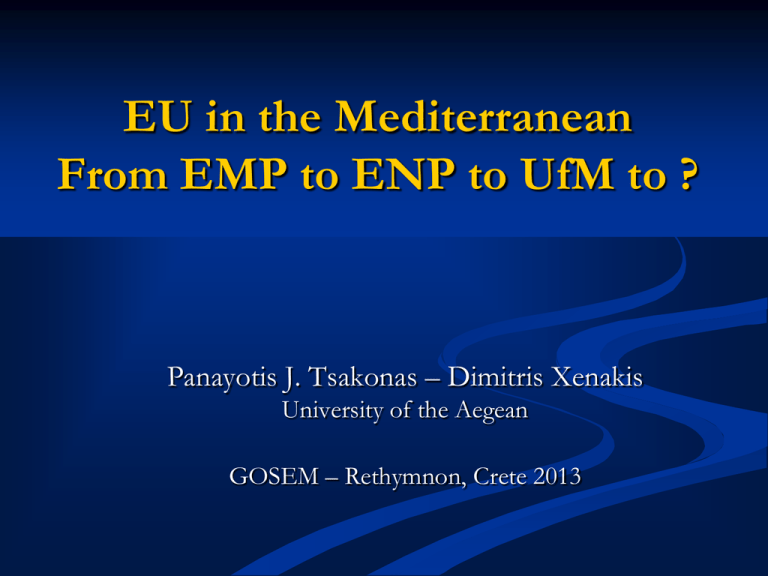
EU in the Mediterranean From EMP to ENP to UfM to ? Panayotis J. Tsakonas – Dimitris Xenakis University of the Aegean GOSEM – Rethymnon, Crete 2013 Background and Previous European Approaches in the Mediterranean The Euro-Mediterranean Partnership (EMP) The Barcelona Process The European Neighbourhood Policy (ENP) The Union for the Mediterranean (UfM) Assessing EU Policies in the Mediterranean Problems and Prospects after the ‘Arab Spring’ 2008 UfM 1995 EMP Previous European Approaches 2004 ENP Barcelona Process 1995-2005 Previous European Approaches in the Mediterranean – Bilateral Agreements EEC member states goal: develop cooperation with countries and territories they had special political, economic and cultural relations due to their colonial past. – 1970s = “global Mediterranean policy” ; 1980s “new Mediterranean policy” 1976 & 1977: Bilateral Agreements Maghreb countries (Algeria, Morocco and Tunisia) and Mashreq countries (Egypt, Jordan, Syria and Lebanon). Direct aid and trade followed and governed relationships up to 1996. 1989-1994: some more limited European Initiatives e.g., “the Mediterranean Forum”, “the 5+5 in the Western Mediterranean”, “the Mediterranean Council”, the “CSCM” etc. Far from triggering any specific attention to the goal of building a more integrated Mediterranean region. EU’s Post Cold War Mediterranean Objectives Bipolatity disappears and the West turns towards the ‘unstable Mediterranean’ zone of socio-economic instability with violent religious and cultural conflicts varying forms of political and economic institutions differing perceptions of security and worldviews intra-Mediterranean trade remains limited north-south economic disparity is resulting in a permanent poverty curtain across the Mediterranean the demographic time-bomb continues ticking illegal migration is reaching alarming levels escalation of protracted conflicts remains a serious concern. EU’s “wishful thinking” for its southern rim: States that will not be at war with each other; be destabilized by socio-economic and political conflicts; export terrorism, or drugs to Europe; threaten Europe’s social stability by continued or even sharply increased flows of illegal immigration. Deepening Euro-Med Relations is a Win-Win Situation The European Perspective The Mediterranean frontier poses enormous demographic and geostrategic advantages. This region has the potential to act as a nexus of cultural dialogue. EU's security and prosperity can only be assured if the South also enjoys security and prosperity. A stable and prosperous Mediterranean will reinforce Europe’s position in the world. The Mediterranean Perspective Importance of the EU on the global Market (27 members), 28% share of the world GDP; 40% of the world merchandise and services trade; 51% out of the world FDI outflows; Ranks 2nd after ASEAN bloc in terms of the population More than 50% of the Mediterranean countries’ trade is with the EU; about 70% of the exports of many Mediterranean countries are directed towards the EU A New Beginning: The Barcelona Process November 1995, the signing of the Barcelona Declaration. Three baskets/pillars of cooperation and a follow up mechanism to ensure continuity of the “process”. Two Dimensions: Regional track (on common issues) and Bilateral Association Agreements One specific financial instrument MEDA (I & II) The Euro-Mediterranean Partnership Membership: EU-25 & 10 Mediterranean Partners (Algeria, Egypt, Israel, Jordan, Lebanon, Morocco, Palestinian Authority, Syria, Tunisia and Turkey). Libya gained observer status in 1999. The Rationale The EU attempted to use ‘soft power’ through economic and fiscal instruments rather than military power to solve critical regional problems from its’ southern rim. Interest-convergence around economic tasks usually contributes to a relaxation of tensions in areas where controversy is more likely to arise. The basket-based structure and the follow-up continuity in line with the Helsinki paradigm (CSCE) could have proved instrumental in fostering a new co-operative ethos among its members (based on communitarian aims and shared values) From a Realist Perspective: EMP was built for: Countering US influence in the region; Controlling the region through the creation of asymmetrical dependency relationships; Containing the emergence of political Islam. The Goals of the EMP Setting up an area of peace and security Providing welfare and development to that area Enhancing its social and human cooperation An ‘Institutionalist Paradise’ Euro-Med Foreign Affairs Ministerial Meetings Euro-Med Meetings of Sectorial Ministers Euro-Med Committee and Group of Senior Officials Euro-Med Parliamentary Assembly Euro-Med Civil Forum Euro-Mediterranean Study Committee (EuroMeSCo) Anna Lindh Euro-Med Foundation for the Dialogue Between Cultures Euro-Med Human Rights Network Euro-Med Heritage Euro-Med Youth Platform Euro-Med Economic and Social Committee Euro-Med Committee of Regions MEDA & FEDIP Principal financial instruments of the EU for implementation of co-operation with Mediterranean partners (Implemented by DG EuropAid it had a double vocation: bilateral and regional) Offered technical & financial support for the reform of economic and social structures in the Mediterranean partners (applied to States, their local and regional authorities as well as actors of their civil society) MEDA I: 1995-1999 : €3,435 million - MEDA II: 2000-2006: €5,350 million. Facility for Euro-Mediterranean Investment and Partnership (FEDIP) – Oct. 2002 (a special financial instrument within the European Investment Bank) Agreements Negotiated and Ratified Bilateral Agreements Negotiated: Tunisia (1995), Israel (1995), Morocco (1996) , Jordan (1997), Egypt (2001), Algeria (2002), Lebanon (2002) and Syria (2004). Bilateral Agreements Ratified: Tunisia (1998), Morocco (2000), Israel (2000), Jordan (2002) and Egypt (2004). Regional Agreements: Agadir Agreement signed in February 2004 by Morocco, Tunisia, Egypt and Jordan. This expressed the intention to set up a free trade area, to meet the 2010 target. The Agadir Declaration was signed in 2001, and was supported with €4m by the EU. Euro-Med Meetings 1995-2007 9th Euro-Mediterranean Conference - Lisbon, 5-6/11/2007 8th Euro-Mediterranean Conference - Tampere, 27-28/11/2006 Anniversary Euro-Mediterranean Summit - Barcelona, 27-28 November 2005 7th Euro-Mediterranean Conference - Luxembourg, 30-31 May 2005 Mid Term Euro-Mediterranean Conference - The Hague, 29-30 November 2004 Mid Term Euro-Mediterranean Conference - Dublin, 5-6 May 2004 6th Euro-Mediterranean Conference - Naples, 2-3 December 2003 Mid Term Euro-Mediterranean Conference - Crete, 26-27 May 2003 5th Euro-Mediterranean Conference - Valencia, 22-23 April 2002 Interim Euro-Mediterranean Conference - Brussels, 5-6 November 2001 4th Euro-Mediterranean Conference - Marseille, 15-16 November 2000 3rd Euro-Mediterranean Conference - Stuttgart, 15-16 April 1999 Ad hoc Euro-Mediterranean Conference - Palermo, 3-4 June 1998 2nd Euro-Mediterranean Conference - Malta, 15-16 April 1997 1st Euro-Mediterranean Conference - Barcelona, 27-28 November 1995 Has EMP Been Successful ? No effects on political cooperation (including democratization and human rights), limited economic results and unimpressive progress in regional social relations Problematic and rather sensitive areas of regional cooperation such as immigration, energy, security and political stability were not properly addressed The Middle East Peace Process was stagnated and intra-regional tensions were deepened Systemic tension has been steadily increasing with the demonized Islam and the events that followed September 11th; Intervention by foreign powers, e.g. the US-led occupation of Iraq continue adversely to influence the levels of security in the region. Weak responses to Med Partners’ economic and social demands; CAP prevented trade in agriculture, a key area for the Mediterranean countries; Trade relations were extremely unbalanced (agriculture) Limited cooperation among the Mediterranean partner-countries; Mediterranean countries expected more constructive cooperation from EU. EU’s Med relations still move on the basis of bilateral rather than regional basis. EU’s internal inertia undermined the capacity and political willingness of partner countries to implement the wide range of reforms originally planned. In its search for a more effective Mediterranean policy, the EU has faced the dilemma of how to reconcile essentially political and security objectives with limited trade and financial instruments. Other impediments relate to the existence and endurance of authoritarian regimes. Political openings and initiatives in the southern Mediterranean have so far remained cautious, selective and controlled by regimes in office. European Neighborhood Policy After it’s enlargement a new framework was launched in 2004 by the EU to create a ‘ring of friends’ and to avoid new ‘dividing lines’. It does not include countries with EU accession prospect: - Ukraine, Moldova, Belarus, Georgia, Armenia, Azerbaijan & Russia (special strategic status) - Syria, Lebanon, Israel, Palestinian Authority, Jordan, Egypt, Libya, Tunisia, Algeria, Morocco. ENP Principles The new framework the EU aspired for it’s partners: “To share benefits of the EU’s 2004 enlargement”; …“To strengthen Security, Stability, Well-being”; …“To develop a mutual commitment to common values” (Rule of law, Good governance, Respect for HR, Principles of market economy & Sustainable development); ….and to enhance economic relations and closer cooperation - Working together (joint ownership) … supporting partners’ own reform processes; and to provide access to EU internal market and programs. Voluntary Basis (increasing flexibility); Differentiated and Progressive approach: Privileged relationships build upon a mutual commitment to common values, as well as the capacity to implement agreed priorities”; Positive Conditionality: Monitoring process of implementation with a financial incentive: European Neighbourhood and Partnership Instrument (ENPI) + Governance Facility; ENP Action Plans & Reports Bilateral Action Plans are jointly agreed political documents that define objectives and actions for reforms and influence technical assistance provided by the EU (there are no regional plans). Not Legally binding ; Country-specific political documents, build upon existing Association Agreements - Commitment to “Common Values” from the Barcelona aquis. Jointly defined agenda on political & economic reforms. Same six chapters in all Action Plans, but content specific to each partner. Priorities: Political dialogue and reforms, Macro-Economic Management, Trade, Migration, Justice and Home affairs, Transport, Energy, Information Society, Environment, People-toPeople contacts. Country Reports are EU analyses of the politico-economic situation that form the basis for the development and assessment of the Action Plans. EU Financial and Technical Assistance Instruments 1. Financial Instruments European Neighborhood and Partnership Instrument (ENPI) Facility for EuroMediterranean Investment and Partnership (FEMIP) Neighborhood Investment Fund 2. Technical Assistance Instruments Technical Assistance & Information Exchange (TAIEX) Twinning Mechanism Competitive and Innovation Program (CIP) 7th Research Framework Program – (FP7) The ENP Instrument & Implementation Tools The ENPI replaced instruments for external policies (geographic and thematic), eg. MEDA & TACIS, and is one of the three major geographical financial instruments of EU external policies. Implementation Tools Country or multi-country (multi-bilateral) programs: i) Covering assistance to one partner country; ii) addressing regional or sub-regional cooperation between two or more partner countries. Cross-border cooperation programs covering cooperation between one or more Member States and one or more partner countries, taking place in regions adjacent to the shared part of the external border of the EU. Thematic programs, addressing one or more specific challenges which may be relevant to one or more Member States. ENP ‘Advantages’ ENP is an ambitious new framework for EU’s relations with neighbors; It embodies the "Wider Europe" concept, namely that the EU will act to promote regional cooperation and integration ENP is of mutual, long-term interest, offering better possibilities for closer cooperation with the EU It provides support for reforms (both political and financial commitment) with the establishment of a dedicated financial instrument, with more resources and more flexible funding of a broader range of activities Through the development of the regional initiatives within the ENP framework, it offers considerable financial and technical assistance and a plethora of opportunities to be used and implemented. Reinvigorating ENP The renewed ENP policy points towards issues that should be reconsidered: It needs to be even more policy-driven, reflecting the ENP vision and addressing specific challenges Main orientations Simplification and shortening of the programming process; Modernization of implementation provisions and alignment and coordination with other external and internal instruments and policies; A specific Cross-Border Cooperation component; An increased budget: from 11.2 billion to 18.2 billion Union for the Mediterranean Union for the Mediterranean (UfM) Launched by Sarkozy in 2007. After the Franco-German agreement the EU Council (March 2008) called it: “Barcelona Process: Union for the Mediterranean”. July 2008, Paris Summit under the co-presidency of The President of France & The President of Egypt. UfM is a partnership, where Northern and Southern countries of the Mediterranean are working on an equal-footing basis, based on “co-responsibility”, “co-appropriation” and “co-decision”. The UfM believes in the value of “Variable Geometry”: each country is collaborating on a project on a voluntary basis respecting national interests of each member states. Union for the Mediterranean Objective: to build on and reinforce the successful elements of the existing Barcelona Process based on: Enhanced multilateral relations, Increased co-ownership of the process Concrete projects visible to the citizens Membership: Sarkozy’s initial plan included only littoral states and was to function like the G8 meetings of Heads of States and governments, with a Council of the Mediterranean modeled on the Council of Europe. Hence, the agreement reached to establish the UfM was the result of the joint, informally orchestrated opposition of Germany, Poland and the UK to unilateral French efforts to establish an exclusive regional cooperation framework. 27 Member States of the European Union, 10 Mediterranean countries which are members of the Barcelona Process Other six countries bordering the Mediterranean (Albania, Croatia, Bosnia and Herzegovina, Montenegro, Monaco and Turkey). Union for the Mediterranean Union for the Mediterranean Co-Presidency 2 directors (one from the EU and one from the Mediterranean countries). Institutional Framework 1. Joint Secretariat (Barcelona) Apply to Summits, all Ministerial meetings, Senior Officials meetings, the Joint Permanent Committee. 2. Joint Permanent Committee Biennial summits of Heads of Government was supposed to be held. 3. Senior Officials (Brussels) Ministers reached a unanimous agreement on the participation of the Arab League at all the meetings and at all levels of the UfM. UfM Organisation UfM Governance • Co-presidencies (France and Egypt) • Senior Officials (monthly summits) A Union of Projects Key Initiatives the de-pollution of the Mediterranean Sea, including coastal and protected marine areas; the establishment of maritime and land highways that connect ports and improve rail connections so as to facilitate movement of people and goods; a joint civil protection program on prevention, preparation and response to natural and man-made disasters; a Mediterranean solar energy plan that explores opportunities for developing alternative energy sources in the region; a Euro-Mediterranean University, inaugurated in Slovenia in June 2008; the Mediterranean Business Development Initiative, which supports small businesses operating in the region by first assessing their needs and then providing technical assistance and access to finance. Funding Funding for regional projects and activities should come mainly from the EU and its Member States; the private sector; contributions from Mediterranean partners; International financial institutions; regional banks; FEMIP; ENPI UfM Added Value The French initiative offered Europe and the international community an opportunity to carry out a strategic reassessment that will allow for more attention and resources to be directed towards the Mediterranean. Wider political visibility backed by 43 countries; Access to secured finance thanks to the enhanced cooperation with the largest development banks operating in the region (EIB, IDB, EBRD, etc); Experts for Upstream Advice, Technical Assistance and Support; Extended network of regional partners could multiply effects. An Overall Critique Contrary to expectations and despite the political capital invested, the UfM, which replaced the EMP in 2008, has failed to impart a new momentum. In the five years of its existence, it has produced very limited results. Because of the institutional arrangements adopted, it has obstructed rather than facilitated political cooperation among states in the region and, by putting economic projects in the forefront, it has pushed values, democracy and human rights to the back seat. Although the UfM meant to reflect a more pragmatic approach to relations with the southern neighbors, it was paralyzed already in its early months by the region’s political reality. Only a few months after the Marseille Conference, Israel’s December 2008-January 2009 military intervention in Gaza convinced Arab partners to plainly suspend the implementation of the new policy and all related meetings. Despite its economic character, the UfM is more vulnerable than the EMP to the paralysis caused from the Arab-Israeli conflict. Contrary to the technical meetings of the Barcelona Process, which brought together ambassadors and experts, in the Summits of the UfM, all controversial issues will be on the agenda of discussions, regardless of the fact that some would prefer to abstain from such discussions to avoid stalemate. UfM: The Way Forward The economic crisis and European negligible interest in investing in the Mediterranean region have practically rendered impossible the implementation of costly projects - the showcase of this initiative. For sure, southern Mediterranean partners do not only expect additional EU aid for their economic development, but also deeper cooperation to deal with the vast challenges they face. Therefore, the focus on the implementation of sectoral projects [Union of Projects’] should not set aside critical region-wide issues, such as democracypromotion, political reform and the strengthening of civil society, not to mention the prevention of another major outbreak of violence in the Middle East. The vision paper on UfM roadmap presented (2012) to the 43 member countries and the European institutions proposed: Realignment of UfM with EU priorities (more consistency with EU regional projects) More coherence with UfM Ministerial meetings Focus priorities on job creation and support to least developed regions The ‘Arab Spring’ 17 Arab states from Morocco to Yemen have felt the ‘spring’; 3 have regime change & fresh constitution (Tunisia, Egypt, Libya); 3 seek progressive political reform (Morocco, Jordan, Oman); 4 use oil manna to keep status quo (Saudi Arabia, Kuwait, Qatar, UAE); 4 have bloody repression or civil war (Libya, Syria, Bahrain, Yemen), of which 2 external military intervention (Libya, Bahrain); 3 fragile but cautious because of civil war memories (Algeria, Lebanon, Iraq); 1 pushes for statehood (Palestine) EU’s Democracy promotion & the ‘Arab awakening’ Paradigm identification – can the EU’s objective of democratization of its neighborhood be driven by conditionality, or mainly socialization? Research suggests that conditionality has worked really well in the EU accession process, but not where there is no membership perspective. Socialization is all about attitudes, awareness, education, understanding of values, etc. It is a long-term and hardly measurable process, but fundamental. Arab spring was home-grown, not a result of external policies. EU’s response to Arab spring is renewal of ‘Conditionality’ discourse, ‘more for more’ - unconvincing, but convenient for speeches of ministers. Democracy technical assistance worth doing where welcome, but don’t think you can buy in democracy on the cheap. An Overburden Security Environment Traditional long-standing conflicts Non-traditional threats and challenges Potential conflicts over the right of certain states to exploit energy resources in contested areas Main Routes EU Energy Security EU Needs Gas demand will remain fairly stable or slightly increase in the coming years to reach 550-600 bcm per year by 2020; EU gas dependency on sources outside Europe will increase from about 60 percent in 2010 to about 75 percent in 2020 and to over 80 percent in 2030. Some 65 percent of the oil and natural gas consumed in Western Europe passes through the Mediterranean each year EU Security Priorities Prioritization of Threats and Challenges to EU’s security on Institutional Documents / Incorporated in the Lisbon Treaty: «European Security Strategy Document» (2003), «Report on the Impementation of the European Security Strategy» (2008) «Annual Reports of the EU’s High Representative for External Affairs and Security Policy» (2009,2011) (1) (2) (3) (4) (5) Diaspora of Weapons of Mass Destruction Terrorism and Organized Crime Cyber-security Energy Security Climate Change Final Note The neighbourhood has fundamental importance for the functioning of the EU and its member states economies Arab Spring: dynamics suggest that it is early to speak of black scenarios. The conduct of a new policy towards the neighbors is largely a matter of the member states’ political will. Emergence of a new way of thinking: stabilization must not be furthered at the expense of democratization. The EU’s Mediterranean policies have been and will long remain hostage to the member states national ambitions and their economic interests. If Europeans genuinely desire to democratize the neighborhood and give credibility to the EU offer, the member states should be called upon to take decisions on trade liberalization of agricultural products, and to declare the introduction of measures facilitating the movement of persons from the South.

